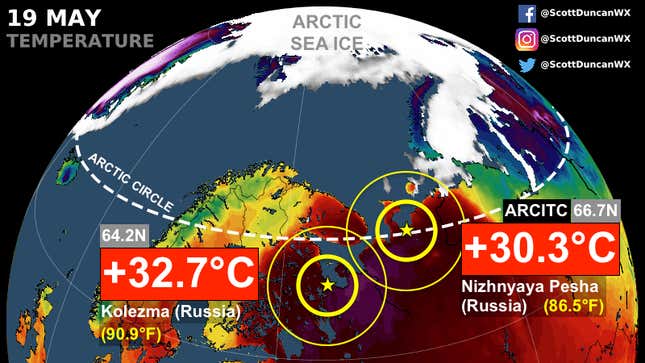
It’s only May, but it feels like summer has arrived in my hometown of Baltimore. Since I woke up, I’ve been counting the hours until I can drink iced cocktails on my deck while wearing a sundress. Can you blame me? It’s 80 degrees Fahrenheit (26.7 degrees Celsius) out.
There’s another reason I really need a drink, though: That’s the same temperature it is in the Arctic today. Welcome to climate hell.
In fact, parts of the Arctic circle got even warmer than that on Wednesday. It was 86.5 degrees (30.3 degrees Celsius) in the Russian town of Nizhnyaya Pesha, and 91 degrees Fahrenheit (32.3 degrees Celsius) in the nearby town of Kolezma. The wildly high temperatures came as part of an ongoing heat wave in the region.
According to meteorologist Scott Duncan, these temperatures are between 37 and 43 degrees Fahrenheit (20 to 24 degrees Celsius) hotter than the region’s average temperature for this time of year. As Duncan said on Twitter, this Arctic heat is “truly exceptional for any time of the year but mind-boggling for May.” But though they’re bizarre, they’re also a sign of the broader changes happening in the Arctic, which is warming more than twice as fast as the rest of the globe.
These high temperatures come months after the Siberian Arctic saw a mind-boggling autumn heat wave broke temperature records. That came after a sweltering summer where temperatures cracked 100 degrees Fahrenheit (37.8 degrees Celsius). The heat brought other shocking impacts as well, including wildfires that released record amounts of carbon dioxide and sea ice extent falling to its second-lowest level on record. Oh yeah, and the heat has literally been causing the tundra to explode. Research shows that the level of warming has already pushed the Arctic outside the bounds of what was once normal.
If the climate crisis continues to worsen, bizarre heat like this will become all the more common in the Arctic. Like, the kind of heat that could make summer sea ice disappear altogether, which could drive more warming because dwindling ice leaves the dark-colored ocean to absorb more heat. Changes in sea ice can also screw with ocean circulation and impact global weather patterns. The heat could also thaw out the region’s carbon-rich permafrost, pushing up global temperatures even more. Both permafrost thaw and ice loss would disastrous for entire Arctic communities and ecosystems.
The current heat wave is just getting started. Startlingly high temperatures will crank up on Thursday in western Siberia, reaching similarly extreme highs. The heat bullseye will shift to the east early next week, engulfing areas that have already seen a growing number of early-season wildfires. So while the balmy weather may be welcome here in Baltimore, in the Arctic, it’s a reminder of the urgency to get carbon emissions under control ASAP.